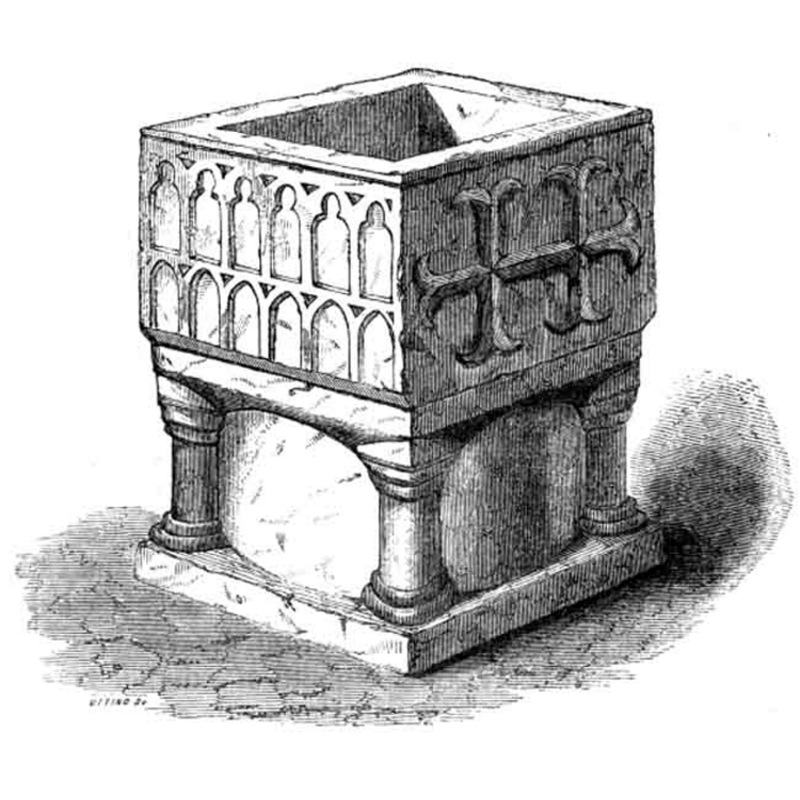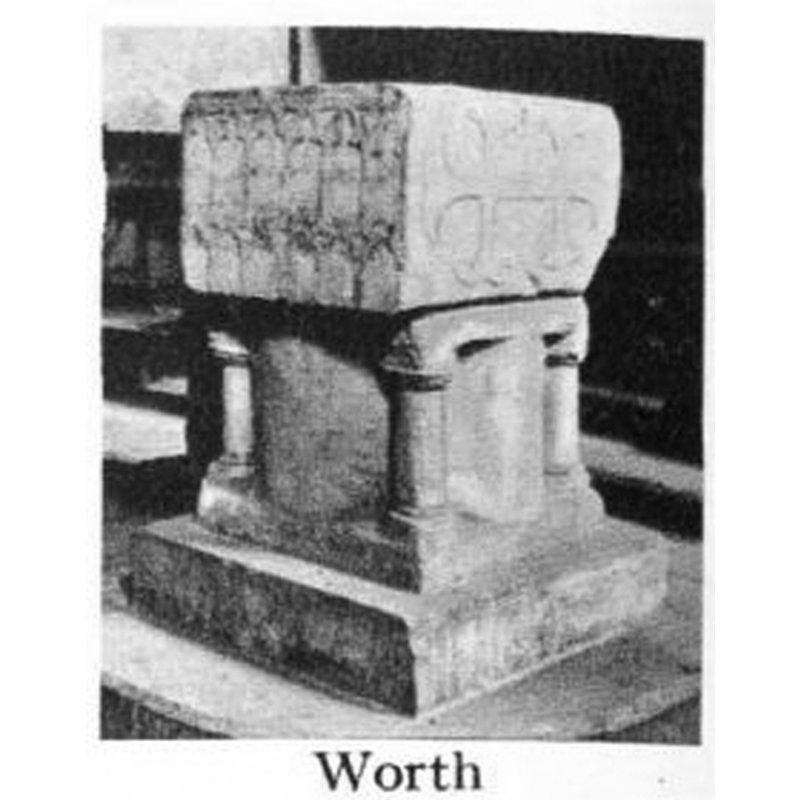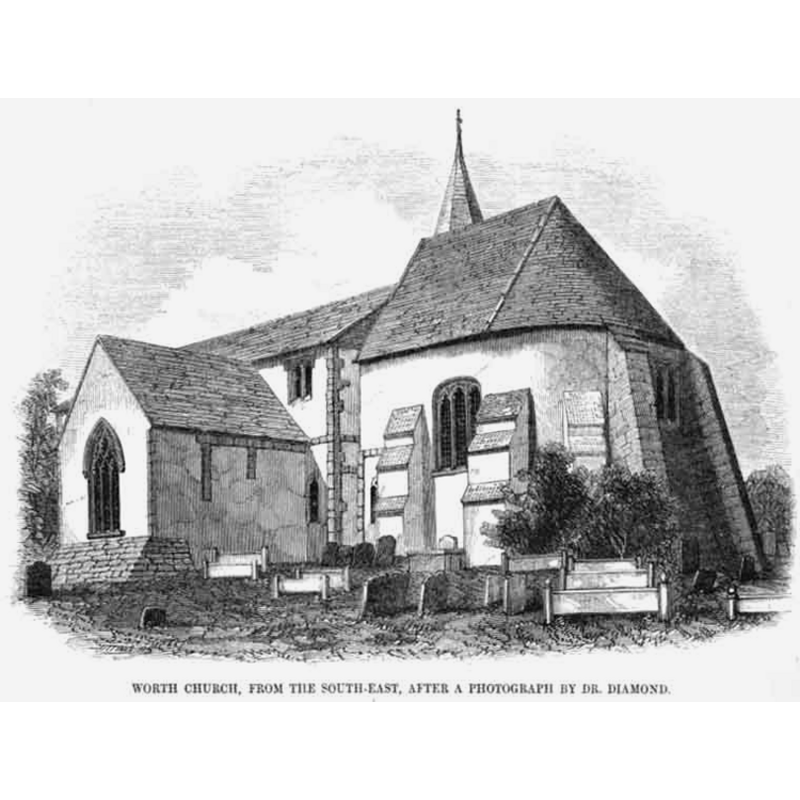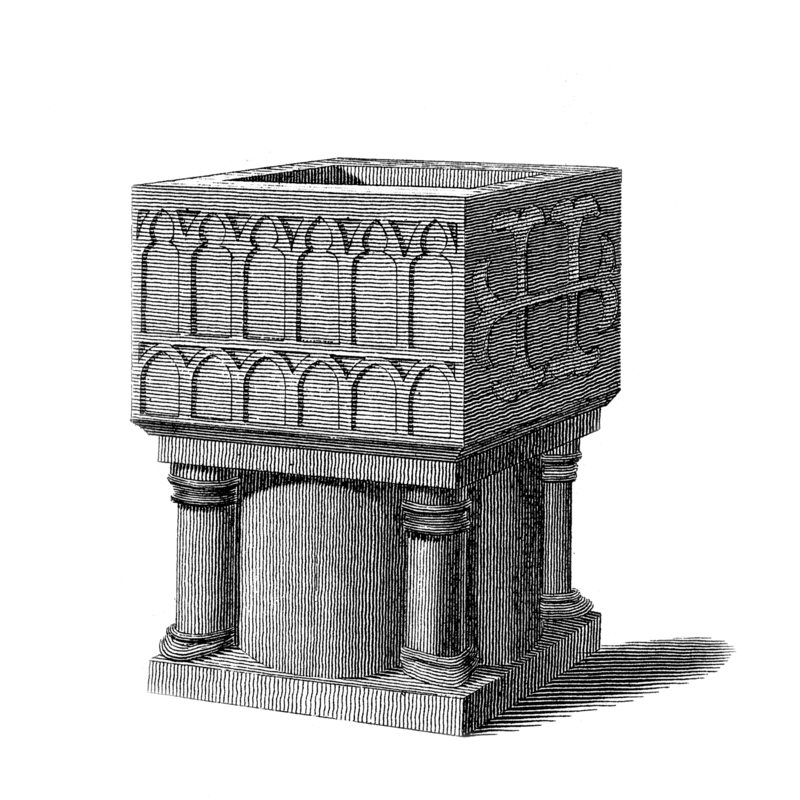Worth No. 1 / Orde

Image copyright © Sussex Archaeological Society, 1856
No known copyright restriction / Fair Dealing
Results: 6 records
B01: design element - architectural - arcade - blind - two-tiers - trefoiled arches
B02: symbol - cross - Greek - double cross (horizontal, linked)
view of church exterior - southeast view
view of font
view of font
view of font
INFORMATION
FontID: 05705WOR
Object Type: Baptismal Font1
Church/Chapel: Parish Church of St. Nicholas
Church Patron Saints: St. Nicholas of Myra
Church Location: Church Road, Worth, West Sussex, RH10 7RT
Country Name: England
Location: West Sussex, South East
Directions to Site: Located just E of Crawley
Ecclesiastic Region: Diocese of Chichester
Historical Region: Hundred of Buttinghill -- Rape of Lewes -- Sussex
Font Location in Church: Inside the church, in the W end, near the S door
Century and Period: 13th century [composite font?] [two fonts?], Medieval [composite]
Cognate Fonts: Other cases of "superposed" fonts at Cornelly (Cornwall), Ewerby (Lincs.), Curdworth (Warwks.)
Credit and Acknowledgements: We are grateful to Paul Zwierzanski, of www.yeoldesussexpages.co.uk, for supplying the source image (Arthur Mee, 1937) of this font.
Church Notes: Harrison (1920): "This church has the unique distinction of being the only Saxon cruciform edifice in the country which is complete and untouched in plan. [...] The chancel arch is the finest and largest Saxon one in England." -- 'Orde' church is included in Surrey in Domesday
Font Notes:
Click to view
Illustrated with an engraving by J. Basire in Repton (1812), who writes that this font was "probably executed from about the reign of King John [1199+] or Henry the Third" [1216+]. Described in Hussey (1852): "The font is a single square stone rudely carved at the sides, and possibly coeval, or nearly so, with the church, though the base is later" [Hussey dates the original church to the Early English period]. A report of a visit by members of the Sussex Archaeological Society to Worth, on 12 July 1855 is reported in The Gentleman's Magazine (issue of August 1855, p. 180): "There are two fonts complete with basins, one placed over the other: their relative antiquity is doubtful, but the lower one may be termed Early English". Walford published an article on the church with an illustration of the font in the S.A.S. journal in 1856 and writes on the font: "The Font, which stands near the south door, is curious : it consists in reality of two fonts placed one upon the other. This is not suggested by its appearance, for the lower, which is 1 foot 6 inches high, is not very unlike many supports of fonts of the twelfth or thirteenth century, being apparently a square resting on a short cylinder between four columns, on a square base common to all. The upper font is 1 foot 44 inches high, and nearly square, viz., 2 feet 2 inches by 2 feet, having three of the sides enriched with ornamental carving, and the fourth plain, as if designed to stand against a wall. The carvings, as it now stands, are, on the south side six pointed quatrefoils, 3 and 3 ; on the cast a double arcade of pointed arches, the lower plain, the upper trifoliated ; and on the north a double cross moline. There is nothing that indicates any great difference of date between the two fonts : a few years before and after the commencement of the thirteenth century might probably suffice for both. Opinions may even differ as to which is the earlier ; but I think the lower one was first executed, and that the other may be as late as the early part of the reign of Henry 111. It is not easy to account for such an arrangement. From the manner in which they fit one on the other, without very obvious marks of mutilation to bring them to this state, the later might seem to have been designed for that purpose, the east and west sides of the upper (which are those farthest apart) being slightly chamfered at their bases to bring them even with the top of the lower font. But, on examination, I think it will be found that the base of the arcade on the east side has been slightly cut away by the chamfer; and this may justify us in concluding that the upper font was not designed for its present situation." Listed in Cox & Harvey (1907) as Early English. Described in Bond (1908) as one of several baptismal fonts consisting of two fonts "superposed". Ditto in Harrison (1920). The Victoria County History (Sussex, vol. 7, 1940) notes: "The church is a remarkable example of a pre-Conquest building of cross-plan dating practically from one period. Whether it can be assigned to an earlier date than the first half of the 11th century is doubtful [...] the church was restored in 1871 [...] The font is probably of the end of the 12th century. It has a square bowl with a different treatment of ornament in each of its four faces. The east has two tiers of six arches, the lower pointed, the upper trefoiled; the north side has a double cross in relief, with a horizontal stem and two shorter upright arms, all with flowered or two-foiled ends; the south has six quatrefoils in two rows, with pointed foils, and the west eight quatrefoils in two rows with rounded foils. The stem is cylindrical, with four small attached shafts cut from the solid: these have moulded capitals and bases of about mid-13th-century date: this stone is said to be another bowl, but looks as though it was made purposely as a stem to carry the earlier bowl above." Described in Whiteman (1994): "13th-century square font with a different decoration carved on each face", without making any reference to the composite character of the object. The basin, or upper element, is a square object, somewhat irregular, with different patterns on each side: one side is decorated with a shallow blind double arcade of trefoil arches -up-and-down, whereas the next side towards the right has two Greek crosses that share a horizontal arm (right arm with left arm). The "base" is probably a full font in his own right, a monolithic table-top type with a broad cylindrival base and four constructive colonnettes at the angles, all raised on a square base, probably Norman, or folowing Norman font canons [NB: we have no information on how this composite font came about] Stocker (1997) lists it as an early font bowl set with the base of successor. Described and illustrated in the CRSBI (2008) with the following remarks: "The upper part of the probably dates from the second quarter of the 13thc., but continues the tradition of columnar Sussex marble fonts which thrived throughout the region in the late 12thc. and early 13thc. It is usually dated to the late 12thc. It has been suggested that the lower block is earlier [cf. Hussey above for the opposite view]. It looks Early English." [cf. Index entry for Worth No. 2 for two later medieval stoups iin this church].
COORDINATES
Church Latitude & Longitude Decimal: 51.1103, -0.1416
Church Latitude & Longitude DMS: 51° 6′ 37.08″ N, 0° 8′ 29.76″ W
UTM: 30U 700079 5665977
MEDIUM AND MEASUREMENTS
Material: stone, sandstone?
Number of Pieces: two?
Font Shape: square (mounted)
Basin Interior Shape: square
Basin Exterior Shape: square
Diameter (inside rim): 43 x 48 cm*
Basin Total Height: 39 cm*
Height of Base: 50 cm [calculated] -- **[45 cm]
Font Height (less Plinth): 89 cm*
Trapezoidal Basin: 61 x 65 x 60.5 x 67 cm* **[65 x 60 cm]
Notes on Measurements: * [CRSBI (2008) -- **[in inches in Walford (1856)]
REFERENCES
Victoria County History [online], University of London, 1993-. Accessed: 2012-11-14 00:00:00. URL: https://www.british-history.ac.uk.
Bond, Francis, Fonts and Font Covers, London: Waterstone, 1985 c1908
Corpus of Romanesque Sculpture in Britain and Ireland, The Corpus of Romanesque Sculpture in Britain and Ireland, The Corpus of Romanesque Sculpture in Britain and Ireland. Accessed: 2006-07-26 00:00:00. URL: http://www.crsbi.ac.uk.
Cox, John Charles, English Church Furniture, New York: E.P. Dutton & Co., 1907
Harrison, Frederick, Notes on Sussex churches, Hove: Combridges, 1920
Hussey, Arthur, Notes on the churches in the counties of Kent, Sussex, and Surrey mentioned in Domesday Book and those of more recent date [...], London: John Russell Smith, 1852
Mee, Arthur, The King's England, Sussex, 1937
Repton, John Adey, "Specimens of Fonts, collected from different Churches, by John Adey Repton, Esq. F.A.S. In a Letter addressed to Craven Ord, Esq. F.R.S. and F.A.S.V.P., read 12th March, 1807", XVI, Archaeologia, 1812, pp. 335-337 and pl. XXXVII-XLV; p. 336 and pl. XL fig. 1
Stocker, D.A., "Fons et origo: The Symbolic Death and Resurrection of English Font Stones", I (1997b), Church Archaeology, 1997, pp. 17-25; p. 24
Walford, W.S., "On the Church at Worth", VIII (1856), Surrey Archaeological Collections, relating to the history and antiquities of the county, 1856
Whiteman, Ken, Ancient Churches of Suffolk, Seaford, East Sussex: S.B. Publications, 1998


